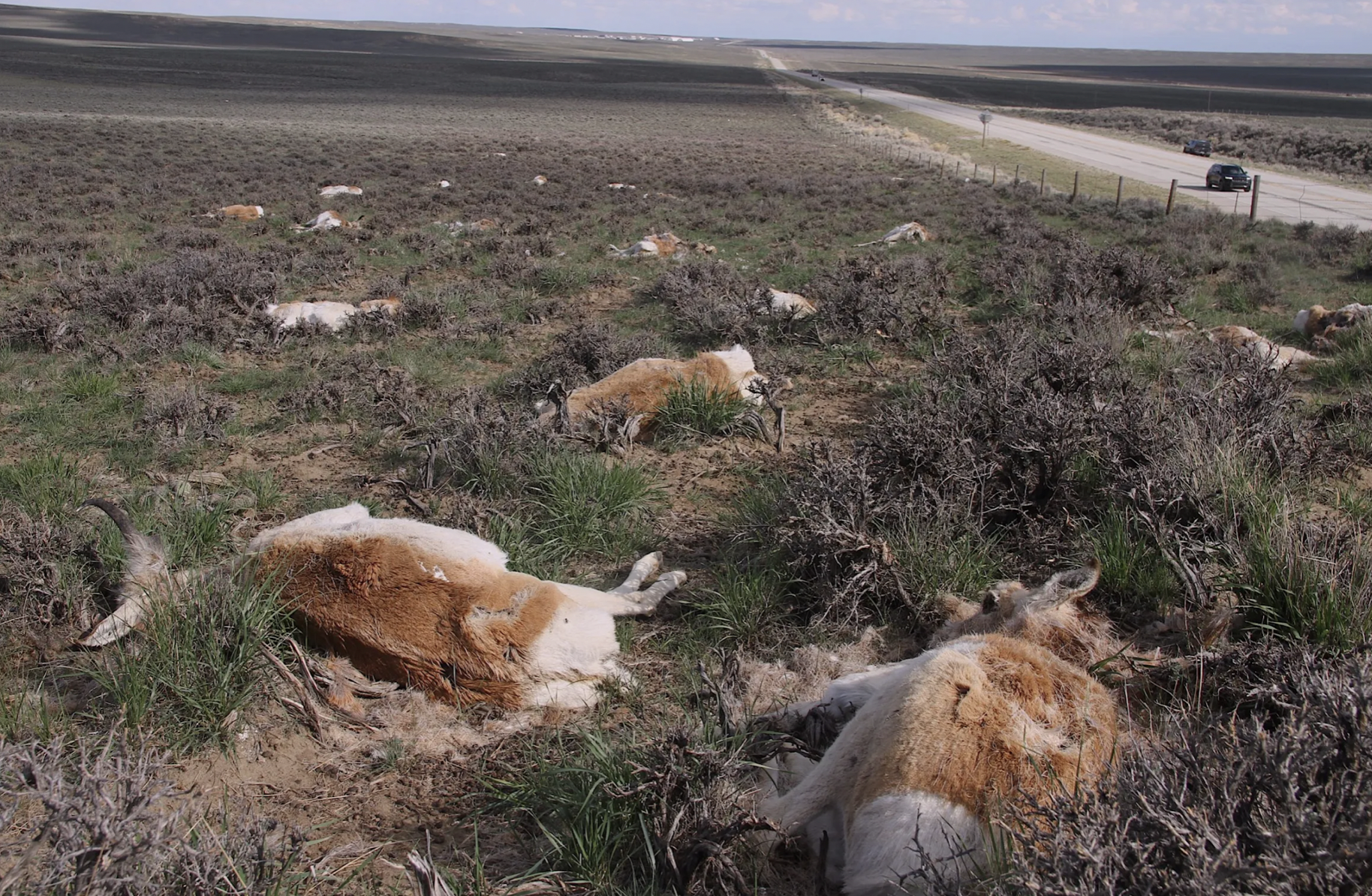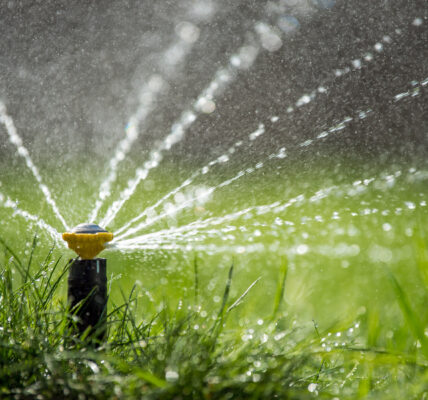
• A year that started off especially deadly for the Sublette Herd of Antilocapra americana threatens to drastically reduce numbers of animals using an ancient, celebrated migration.
By Mike Koshmrl, WyoFile.com
A collared pronghorn took her last breath on Feb. 16. The adult doe’s remains were found on the south end of the Pinedale Mesa.
Another marked-and-tracked doe died a couple days later, just 500 yards away. A week later the third adult female went, her final resting place a mile or so north of her migratory compatriots.
With that, every collared animal that traveled the celebrated Path of the Pronghorn in 2022 was dead.
It was a grim sign for a migratory pronghorn population that has thrived in recent years. Now, following the deadliest winter on record in which a disease outbreak compounded fatalities, the fate of the long-distance travelers that winter in the Green River basin but sojourn for the summer in Grand Teton National Park, the National Elk Refuge and along the Gros Ventre River is unclear. Wildlife scientists aren’t sure how many remain.
“Anything’s possible, right?” Brandon Scurlock, a regional wildlife coordinator for the Wyoming Game and Fish Department, said. “But I would have to think that some of those animals made it and will make that migration.”
But the outlook is grim, with the large majority of animals from the larger Sublette Herd likely dead, according to Scurlock. Pronghorn in the herd were being closely studied as the state considers whether to recognize and protect a route that remains undesignated due to political pressure from industry groups. The monitoring effort tracked 83 does throughout the herd as recently as December. By Tuesday, when Scurlock spoke to WyoFile, just 21 of them were still alive — including zero of the Jackson Hole migrants.
“We lost 75% of our collared animals,” he said. “It’s erroneous to [extrapolate] that 75% to the entire herd, but that’s our best indication of survival. If we did have 400 or 500 [Jackson Hole migrants], our best guess is that 75% of those might be gone.”
In Jackson Hole pronghorns’ favor is that the migratory population has thrived of late. Counts in 2020 and 2021 were the highest on record.
If the so-called Path of the Pronghorn does live on, it’s all but assured that drastically fewer animals will make the journey, which cuts through gas fields, skirts coming-soon subdivisions and treads over a mountain pass.
Lost before
An archaeological site along the migration route at Trappers Point holds evidence that humans have hunted pronghorn along the path as long as 6,000 years ago.
But even within that long history, the Path of the Pronghorn has faded before.
Joel Berger, a Wildlife Conservation Society researcher and former Jackson Hole resident, was part of the multi-agency research team around the turn of the century that first mapped the route. The science led to the Bridger-Teton National Forest amending its management plan, in essence creating the first federally designated migration corridor in the United States. The southern reaches remain undesignated — to the chagrin of some wildlife advocates.
“Early reports were a couple of thousand around the turn of the century, then they went extinct locally in Jackson,” Berger said.
The migration route was lost, he estimated, between about 1910 and the 1950s.
“The pronghorn were just all shot out,” Berger said, “because we didn’t have good conservation in those days.”
Green River basin pronghorn evidently learned the ancient route into modern day Teton County again some four decades later. Berger likened them finding their way back to a pinball player’s inevitable outcome.
“What happens? Ultimately, the ball ends up in the hole, right?” Berger said. “From our GPS data we know they were bouncing all over, but the only access into Jackson was the single route.”
Fast forward to the present, and management of the pronghorn herd is much more deliberate and science-based.
Game and Fish and the National Park Service not only survey the Jackson segment annually, the state agency keeps close tabs on numbers within the entire herd, which spans western Wyoming from Green River to northern Grand Teton National Park. The population breached 60,000 in the early 2000s but was last estimated at 43,000, Scurlock said.
In past bad winters over the last couple decades the herd has fared OK.
“We know we did lose some pronghorn in ‘16-’17, but this winter was unprecedented in terms of the number of days below zero and the depth of the snow on the winter range. ” Scurlock said. “We just didn’t see these large foci of carcasses [in ‘16-’17].”
In the wake of winter 2022-’23, there are conspicuous concentrations of death scattered throughout the region. Motorists can see them without leaving their vehicle in places like the East Fork hill, located on the east side of Highway 191 between Farson and Boulder.
“We’re seeing these clusters of animals on the landscape that are now dead,” Scurlock said. “Rock Springs to Boulder, over to Big Piney, down by Kemmerer.”
Outbreaks of mycoplasma bovis, a new affliction in the Green River basin that causes a deadly respiratory disease, have been observed in the hardest-hit areas, he said. The carcass of the first Jackson Hole migrant that died this winter was shipped to a Laramie laboratory and tested positive for the disease.
The verdict
There are a few bright spots better for survival along the southern fringes of the Sublette Herd’s high desert home, Scurlock said. Those areas, he said, include the Red Desert between the Killpecker Sand Dunes and the town of Superior and the bluffy country overlooking Interstate 80 near James Town.
Although it’s an open question what remains of the Jackson Hole segment, answers should come through in the next couple weeks.
“In a nutshell, we won’t know until they show up in June,” Game and Fish wildlife biologist Aly Courtemanch said.
State and federal agencies will partner to do a more-thorough census of what’s left later in the summer. Game and Fish has drastically reduced hunting opportunities to give the herd its best shot at recovery. Doe and fawn hunting — which has the most impact on populations — has been eliminated in all hunt areas roamed by the herd, Scurlock said.
“They are fairly fecund, and they can bounce back pretty quick just because they have twins as the norm,” he said. “Our plan is to give the herd the maximum opportunity to bounce back by eliminating that reproductive harvest.”
Still, the population’s starting point will likely be significantly lower than wildlife managers have seen in their lifetimes. They’re beginning to see what that looks like.
Game and Fish biologist Gary Fralick’s territory doesn’t cover the Sublette Pronghorn Herd, but he drove through a swath of its habitat on Monday on his way to take a look at what’s left of the Wyoming Range Mule Deer Herd.
Typically there’d be “several hundred” pronghorn foraging this time of year on pastureland and in the sagebrush from the Hoback Rim down to Daniel Junction, he said.
Fralick, a 30-year veteran at his biologist post, saw only 11 animals. Their absence, he said, isn’t because of a delayed migration. It’s because they’re dead.
“Since I’ve been around, in that country it’s always the pronghorn leading the deer,” Fralick said. “And they’re not there.”
WyoFile is an independent nonprofit news organization focused on Wyoming people, places and policy.





